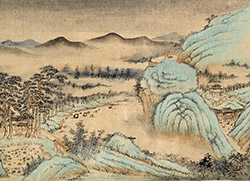| The practice of literati painting is often romantically imagined as a lonely pursuit, with emphasis on the personality of the painter. However, in actuality it was a more complex matter of social relations and economics. Many painters had students (often family members) and their production amounted to that of a workshop. Better students might be designated to represent the painter's style, and their completed works might even be signed by the master – a sort of quality assurance label. Broadly, the studio would produce a range of quality, with better works commanding higher prices or being exchanged for more valuable social favours. Other painters in the vicinity would also be inclined to work in a successful and recognised style, so making for an even wider 'school.' It might therefore be reasonably argued that collectors and connoisseurs should understand classical painting as a progression of schools as much as masters. Adapting this looser distinction allows for more concern for quality per se and also for a proper appreciation of the historic production of work – without the distraction of supposing that the work of a school is no better than the work of forgers. In the examples here the upper painting is more likely by the master as it shows a more sophisticated and imaginative handling of space undertaken in fluid brushwork. By contrast the lower work is probably of his studio, as it is more rigid in its expression and the imagery is more predictable and genre-like. | | 
 |